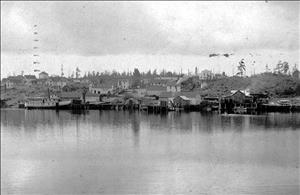On February 2, 1909, voters approve the incorporation of Friday Harbor as a town of the fourth class and elect a mayor and town council. Election results are certified by the San Juan County Board of County Commissioners on February 8 and become effective on February 9 with the first Town Council meeting held the following day. Friday Harbor is seat of the San Juan County.
1909 Incorporation
The area on the central eastern shore of San Juan Island that would become San Juan County's largest settlement and only incorporated town was essentially uninhabited when Edward Warbass (1825-1906), who as a territorial legislator spearheaded creation of the county and then served as its first auditor, selected land on a protected bay known as Friday Harbor as the county seat in 1873. Warbass was Friday Harbor's only resident for several years, and it was not until the mid-1880s that the town began to grow, but once it did, growth was rapid.
At the beginning of the twentieth century, with economic good times and increasing numbers of immigrants to the region, Friday Harbor was experiencing growing pains. One pressing need was to find a safe and dependable water source for both residents and waterfront business. In 1906 a Friday Harbor Journal writer suggested that the solution to the town's problems could come from incorporation.
Not everyone agreed, but 53 of Friday Harbor's 405 residents met on January 12, 1909, and chose a steering committee to plan for incorporation. The issue was added to the ballot for the election held on February 2, 1909. Anti-Saloon League members objected to Saloon Best proprietor John Douglas (1859-?) serving on the steering committee, but Douglas not only stayed on to plan, he also won himself a council seat in the same election that approved the incorporation measure.
The vote in favor of incorporation was fairly narrow, with 70 in favor and 55 opposed. Gene Gould (1879-1957), a young bank president, was chosen as mayor and, along with John Douglas, town council members were merchants L. B. Carter (b. 1858) and Norman E. Churchill (1852-1915), creamery owner Sam Bugge (1870-1939), and dentist C. L. McGinnis (d. 1928).
One of the new council's first acts was to approve a gravity-fed water system originating at Trout Lake, located a few miles west of Friday Harbor in the hills near the island's western shore on Haro Strait. The system was in operation by 1913.
2009 Celebration
Friday Harbor celebrated its 100th birthday in style on February 9, 2009 with more commemorative events taking place throughout the year. Planned by the town’s Centennial Commission, the San Juan Island Historical Society and Museum, the Community Theater, the Friday Harbor Historical Preservation Board, the San Juan Island Library, Skagit Valley College, the Lummi Tribes and the local Grange, the birthday party was largely financed by the San Juan Island Community Foundation.
Students, teachers, city officials, Color Guard Battery D, the Washington State Ferries, local artists and musicians all participated in the celebration. Ferries sounded their whistles all day, on arriving and departing, and ferry crews announced the Friday Harbor birthday over their PA systems. There was a Beard Growing contest, a hip-hop dance performed by Friday Harbor High School cheerleaders, and 1900s music. In the evening the Yacht Club hosted a dinner and dance. The Community Theater staged a production of Thornton Wilder’s “Our Town” later in February, the Friday Harbor fire department published its history, and there was an ongoing painting display.
Authors Mike and Julia Vouri and the San Juan Island Historical Society and Museum produced Friday Harbor, an Arcadia Press book in its Image of America series, the Lions Club made a 12-month calendar and commemorative license plate holders, T-Shirts and pencils were sold.
The Lummi Nation hosted three days of events in July, honoring their historical ties to the San Juan Islands, the town’s anniversary and the Fourth of July. Some paddled canoes into the harbor and embarked onshore below Coast Salish house posts, others provided music and food or exhibited their artwork -- carvings, photographs, weavings, and prints.

